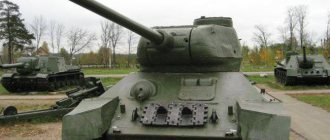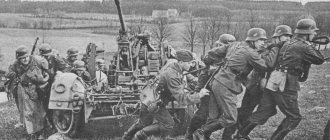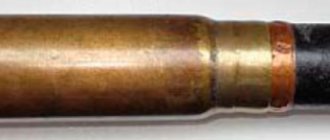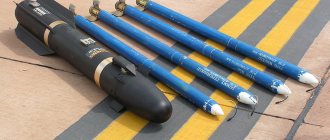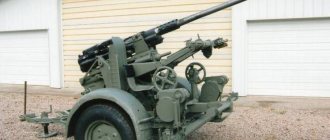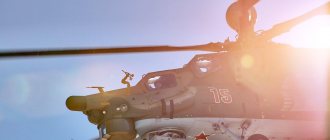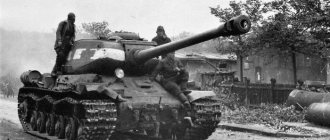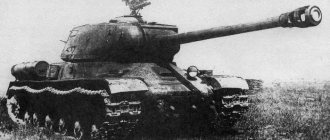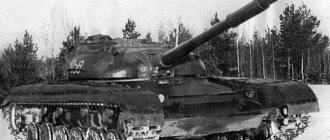Firepower
Early T-34-85 tanks were equipped with an 85-mm D-5T (or D-5-T85) cannon with a barrel length of 51.6 calibers. Gun weight 1,530 kg. The maximum rollback length is 320 mm. The gun had a wedge breech, similar in design to the breech of the F-34 cannon, and a semi-automatic copy type. The recoil devices consisted of a hydraulic recoil brake and a hydropneumatic knurl and were located above the barrel: on the right side there was a knurl, on the left there was a recoil brake.
Internal view of the T-34-85 tank turret (front side):
1 – loader’s seat; 2 – sleeve catcher; 3 – gunner’s seat; 4 – turret rotation mechanism; 5 – capture of the turret ring; 6 – locking device for the opening for firing from personal weapons; 7 – button for turning on the backlight of the protractor; 8 – electrical panel of tower equipment; 9 – sight suspension; 10 – MK-4 observation devices; 11 – sight TSh-16; 12 – sight lighting shield; 13 – gun; 14 – tower lighting lamp; 15 – coaxial machine gun; 16 – stacking of machine gun magazines on the right side of the turret; 17 – tower stopper; 18 – device No. 1 TPU
Since March 1944, the T-34-85 tank was equipped with an 85-mm S-53 (and then ZIS-S-53) gun mod. 1944 with a barrel length of 54.6 calibers. The mass of the swinging part of the gun without armor is 1,150 kg. The maximum rollback length is 330 mm. Vertical aiming from –5° to +22°. The gun bolt is a vertical wedge with a semi-automatic copy type. The gun's trigger mechanism consisted of electric and mechanical (manual) triggers. The electric release lever was located on the handle of the lifting mechanism flywheel, and the manual release lever was located on the left shield of the gun fence.
For firing from 85-mm tank guns, standard ammunition from an 85-mm anti-aircraft gun mod. 1939:
– a unitary cartridge with an armor-piercing blunt-head tracer projectile (BR-365) with a ballistic tip with MD-5 and MD-7 fuses;
– a unitary cartridge with an armor-piercing tracer sharp-headed projectile (BR-365K) with an MD-8 fuse;
– unitary cartridge with a fragmentation steel grenade (O-365K) with a KTM-1 fuse;
– a unitary cartridge with a sub-caliber armor-piercing tracer projectile BR-365P (put into service in February 1944).
Placement of ammunition racks in the tank:
1 – placement of artillery rounds on the right side of the tower; 2 – placement of artillery rounds in the tower niche; 3 – placement of artillery rounds in the right corner of the fighting compartment; 4 – stowage of machine gun magazines to the left of the driver’s seat; 5 – placement of artillery rounds on the floor of the fighting compartment in boxes; 6 – placement of machine gun magazines on the lower bow plate of the hull; 7 – stowage of machine gun magazines in the control compartment to the right of the machine gunner’s seat; 8 – placement of artillery rounds in the control compartment; 9 – stacking of machine gun magazines on the right side of the turret
The gun's ammunition consisted of 55 artillery rounds (fragmentation rounds - 36, armor-piercing rounds - 14, sub-caliber rounds - 5) and was placed in the hull and turret of the tank in three types of stowage: rack, clamp and box.
The rack for 12 shots was located in the niche of the tower. It included shots with a fragmentation grenade.
The clamp racks were located: on the right side of the turret - for 4 artillery rounds; in the control compartment on the starboard side of the hull - for 2 artillery rounds; in the right rear corner of the fighting compartment - for 2 artillery rounds. On the right side of the turret shots with armor-piercing shells were stacked, and in the control and combat compartments - with sub-caliber shells. Thus, the T-34-85 had 20 artillery rounds in constant readiness to immediately open fire.
Six boxes located on the bottom of the fighting compartment contained 35 rounds, of which: 24 with a fragmentation grenade, 10 with an armor-piercing projectile and 1 with a sub-caliber one.
If we take the German heavy tank “Tiger” as a kind of calculation unit, then we can state that its frontal armor was pierced by 85-mm cannons at a range of 1000 m. When firing at the tank “Tiger” from a range of 1500 m, there remained in its frontal hull plate only a dent 39 mm deep, and at a distance of 800 m a gap measuring 350 by 230 mm formed in the side of the turret box. The 85-mm cannon of the Ferdinand self-propelled gun and the Royal Tiger heavy tank penetrated only the side and rear armor plates of the hull and turret. It should be noted that in terms of manufacturing quality, Soviet armor-piercing shells were somewhat inferior to German ones, which did not allow the full potential of tank guns to be used. At the same time, the comparison with German heavy tanks looks incorrect, since the T-34-85, being a massive tank of the Red Army, more often dealt with the Pz.IV and the Panther. The first was hit by an 85-mm armor-piercing projectile at almost all firing distances, while the situation with the second was much worse. The frontal plate of the Panther's hull was 85 mm thick and tilted to the horizon at 35°; the T-34-85 tank's gun could only penetrate it from a distance not exceeding 500 m.
T-34-85. An intermediate model that retained some of the characteristic details of early Sormovo cars: an external fuel tank shifted forward and eyelets made of rod
Compared to the T-34, the T-34-85 has significantly improved fire maneuvers. The turret rotation mechanism had a combined control of manual and electric drives, which greatly facilitated its use. Using an electric drive, the tower made a full rotation in 12-15 seconds.
For direct fire from the D-5T cannon, the TSh-15 telescopic sight and the PTK-5 periscopic sight were used, and from the S-53 and ZIS-S-53 cannons, the TSh-16 telescopic sight was used. For shooting from closed positions - a side level and a turret inclinometer.
Telescopic sights TSh-15 and TSh-16 had a 4x magnification and a field of view of 16°.
Both of them had an optical hinge consisting of four mirrors. The head part of the sight was rigidly mounted on the swinging part of the gun, and the eyepiece part was stationary, which significantly improved the gunner’s working conditions.
However, the T-34-85 has significantly improved working conditions for all crew members. For example, the width of the gunner’s workplace at the shoulders was 500 mm, that is, it became equal to that of the Pz.IV or Panther. The width of the loader's workplace was 500x900 mm and, again, was equal to the Panther. At the same time, the length of unitary cartridges for both tanks was approximately the same. The loader's workplace in the Pz.IV was smaller than in the T-34-85. Only the Tiger was superior to the “thirty-four” in all these indicators.
TTX T-34-85
Dynamics
| Maximum speed | 54 km/h |
| Power density | 17.83 hp/t |
| Chassis traverse speed | 38 degrees/sec. |
| Turret traverse speed | 46 degrees/sec. |
Vitality
| Number of units strength | 670 units |
| Hull armor | 45 / 45 / 40 mm |
| Tower armor | 90 / 75 / 52 mm |
Firepower
| Average one-time damage | 180 units |
| Average armor penetration | 144 mm |
| Mixing time | 2.3 sec. |
| Recharge time | 6 sec. |
| Gun spread | 0.37 m |
| Ammunition | 48 pcs. |
Review
| View radius | 360 m |
Security
The first prototype of the T-34-85M tank. Spring 1944
When considering the armor protection of the T-34-85 tank, it should be taken into account that the hull was completely borrowed (except for the turret plate) from the T-34 tank. When putting the T-34-85 into mass production, in general, it was planned to increase the thickness of the hull armor plates. In April 1944, Plant No. 183 produced two samples of the T-34-85M tank. The thickness of the frontal hull plate was 75 mm, the thickness of the driver's hatch cover was increased to 100 mm, and the front machine gun armor was 90 mm. At the same time, we had to reduce bookings where possible. The thickness of the MTO roof sheets, the bottom of the fender liners, the lower stern sheet, and the rear part of the bottom was reduced to 15 mm. Lightweight balancers and road wheels were used in the chassis. During the tests, it turned out that these measures did not produce much results. In addition, shelling tests revealed that 75 mm frontal armor is penetrated by a shell from an 88 mm German KwK 43 L/71 tank gun from a distance of 2000 m! Thus, there was no point in strengthening the frontal armor of the hull in 1944.
The second prototype of the T-34-85M tank. Spring 1944. The modified configuration of the rear hull is clearly visible, associated with the placement of two 190-liter fuel tanks there.
Since the main innovation of the 7-34-85 was the turret, the designers focused their main efforts on it. By that time, it was already known from war experience that the turret accounted for up to 45% of dangerous tank damage. The base of the tower was cast from 71L steel, which had higher casting performance than the MZ-2 steel previously used for T-34 towers. The thickness of the front part of the tower was 75 mm, the sides and rear - 52 mm. From August 7, 1944, the thickness of the frontal part of the turret began to be 90 mm. The thickness of the turret sides was increased to 75 mm. In combination with their slight inclination, this thickness provided protection against armor-piercing shells of the 75-mm Pak 40 anti-tank gun at a distance of about 500 m at heading angles of up to 40°.
The frontal armor provided protection against German armor-piercing shells from ranges of 800–2000 m, depending on the caliber and type of ammunition.
Thus, the level of armor protection of the T-34-85 compared to the T-34 tank armed with a 76-mm cannon has increased slightly. But if we talk about security in general, it has increased quite significantly. The decisive influence on this process was not the strengthening of the turret's armor, but the installation of a new powerful gun in it. Thanks to this, it was possible to increase the firing distance and, as a result, reduce the likelihood of the tank being hit by enemy shells. The placement of a third crew member in the turret was also important. Now the tank commander, having gotten rid of the functions of a gunner, could fully concentrate on observing the battlefield, searching for targets and assessing the situation. As a result, the effectiveness of the tank's preemptive and retaliatory fire against tank-hazardous targets and the effectiveness of its anti-artillery maneuver have increased significantly. This was fully facilitated by equipping the T-34-85 with high-quality surveillance devices and radio communications.
Comparative sizes of T-34 and T-34-85 tanks
As for observation devices, the driver-mechanic of the T-34-85 remained at his disposal: he still had at his disposal two prismatic viewing devices, closed with armored “eyelash” flaps. The machine gunner (former gunner-radio operator) located to his right from December 1944 received at his disposal a PPU-8T optical telescopic sight with a field of view of 25°. As a result, such an assessment of the effectiveness of a course machine gun, equipped only with a diopter sight, the field of view of which was limited by a hole in the ball mount - 2-3°, began to become a thing of the past: “The view through this hole above the barrel of the machine gun was limited, and the field of fire was even smaller. Sometimes you turn the machine gun, you see that someone is running, but you can’t shoot.” Nevertheless, front-mounted machine guns were very useful in 1944-1945 to fight the Faustians.
Welding the roof to the base of the T-34-85 turret. Uralvagonzavod, 1944
A real breakthrough was the equipping of the T-34-85 with three MK-4 periscope rotating observation devices. The gunner's and loader's instruments were located in the turret roof, and the commander's instrument was located in the hatch cover of the commander's cupola. The MK-4 device provided recognition of objects on the ground at a distance of 1,000–1,200 m. In this regard, I would like to draw the reader’s attention to one circumstance. The fact is that the MK-4 device is not a domestic invention. It was copied in the spring of 1943 from the English Mk IV device, which was installed on British tanks supplied to the USSR under Lend-Lease, and is considered almost the best observation device during the Second World War and even beyond. And here it’s unclear - what were they waiting for before 1943? The first British tanks arrived in the USSR in the late autumn of 1941, and the surveillance devices on the T-34 were subject to severe criticism since 1940! All reports on tests of British tanks note the good quality and ease of use of observation devices. In such reports, by the way, there was always a list of things that would be nice to borrow from “foreigners.” The Mk IV device almost always occupied first place in it. But, apparently, our production workers in 1942-1943 had no time for surveillance devices.
It is interesting to note that the Mk IV is not a British invention. It was developed by the Polish engineer Gundlach in the mid-1930s, and the British simply acquired a license to produce it. Our military was able to get acquainted with this device back in 1939 when testing the captured Polish tank 7TR and even then they included this device in the list of “what to borrow”!
The T-34-85 commander’s performance of his duties was greatly facilitated by the commander’s cupola, the wall thickness of which was increased from 52 to 75 mm during serial production. Along the perimeter of the commander's cupola there were five viewing slots covered with glass blocks. The MK-4 observation device was located in the rotating hatch cover of the turret (double- or single-leaf).
T-34-85 tank armor scheme
The equipment of all tanks with radio stations had a significant impact on the level of security of the T-34-85. Moreover, the most advanced tank radio station of the Second World War period, the 9RS, was installed on combat vehicles of this type. Unlike the previously produced 9RM, it was made compactly in one unit and was designed to be powered from an on-board 24 V network. On the T-34-85, the radio station was moved from the hull to the turret - now it was serviced by the tank commander. The latter circumstance excluded the intermediate link from the communication chain - the gunner-radio operator. Now the tank commander had direct contact with the unit commander. As a result, the interaction of both individual tanks and units on the battlefield has dramatically improved.
Equipment
The T-34-85 is a classic Soviet tank that needs to improve its firepower and viewing radius.
A medium-caliber rammer will speed up an already good reload. The vertical aiming stabilizer will allow you to shoot more accurately while moving. Improved ventilation will improve the performance of the entire crew by 5%, including reloading.
But with such equipment, the tank will have poor light, since the standard review of the council is 360 m. This is the average for a level 6 ST, which can be brought to acceptable results using the following equipment:
By replacing the vertical stabilizer with coated optics, the tank will be less likely to hit while on the move, but will be able to independently illuminate enemy vehicles. This combination will be very effective in positional firefights.
